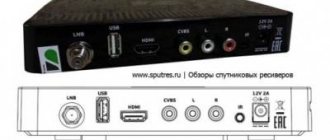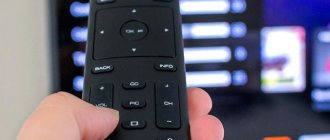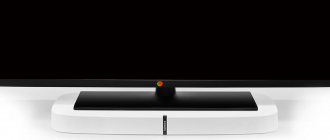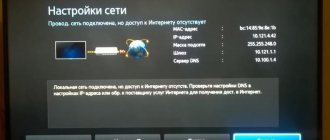Rippling or flickering on the screen is strongly associated with old CRT televisions, but in practice the problem can also affect modern technology. Even if the model supports the most advanced formats with high quality transmitted images, this does not guarantee image stability. The appearance of ripples, screen flickering and other interference is a phenomenon in which watching TV will at least no longer be comfortable; it can be associated with various factors and, except for those cases where the problem arose one-time and resolved itself, requires diagnostics and corrective actions.
Some problems can be corrected by the user, while others require contacting service specialists. Let's look at why the TV screen ripples, what are the diagnostic features depending on the type of television broadcast, and how to solve the problem.
Technical side of malfunctions
Diagnostic measures for the problem when the TV blinks consist of searching for the cause, which determines the method of correction. Some problems are easy to fix, others require professional help, and in the latter case, trying to solve the problem yourself can lead to dire consequences. First, you need to understand why your TV screen is flickering by performing diagnostics based on the following signs:
- Screen flickering is observed when watching TV via cable, while when connected to the Internet the image is stable - the problem is in the antenna;
- if the cable connector is damaged, the picture deteriorates and blinks, in this case the socket requires replacement, the procedure should be carried out by a specialist;
- Screen flickering in the case of satellite TV can be a one-time problem, usually caused by increased cloudiness;
- LCD TVs are characterized by regular flickering when the power board is faulty.
What to do if the TV screen of LG, Samsung, etc. flickers?
Users encounter this problem quite often. The main difficulty lies in determining the cause of the problem. It is extremely difficult to answer unequivocally why the TV screen blinks? The diagnostic result directly depends on the signal source. Hardware faults cannot be ruled out. It is likely that the failure of basic components is the cause of interference. Now let's look at the most common causes of TV screen flickering, and also analyze effective ways to solve this problem.
Types of faults
To solve the problem, it is important to track the moment of its occurrence and determine the nature of the manifestation, which will allow you to understand why the TV screen is blinking and take appropriate measures.
Connecting peripherals
If the picture on the screen starts flickering only after connecting external USB devices to the TV, you can confidently attribute the problem to the USB port. A connector malfunction can be caused by natural wear and tear during long-term use or failure as a result of careless user actions.
Flickering while watching TV channels
The cause of the problem of a flickering screen when watching TV may be an incorrect installation of the antenna or a settings failure. In this case, the solution is to adjust and fix the device.
Bad signal
One of the reasons why the screen blinks, as well as other interference observed when the TV is operating, is damage or incorrect settings of the TV signal receiving source.
Screen blinks constantly
The reason that the TV screen from LG, Samsung or other manufacturers of modern models constantly blinks may be a damaged cable or a broken power supply. The phenomenon often occurs on LCD screens, and to fix the problem you need to replace the power supply.
Why is the screen blinking?
The occurrence of such a malfunction is related to the type of TV. Today, specialized stores offer a huge range of these devices. You can buy the latest TV or buy an outdated model. This defect occurs quite often on older products. If this happened with a new receiver, then we can talk about a problem.
Screen flickering is associated with a specific type of TV. Failures are divided into several groups:
- CRT. The frame scan has gone wrong or the power board has failed.
- Liquid crystal. The power board is malfunctioning.
- Plasma. The antenna is installed incorrectly, the reception signal is intermittent.
Note! Modern plasma TVs always show a stable image. It is unusual for these devices to show a bad picture. The image is seriously influenced by external factors. This mainly concerns the antenna and supply cable.
The nature of malfunctions depending on the type of television
Connection problems are diagnosed when the screen flickers when a signal source is connected. There may be a problem with the antenna, cable or receiver. The first thing you need to do when the TV screen is flickering is to identify the element responsible for the problem, which will allow you to exclude or confirm the connection between the problem and the source of the TV signal.
Satellite television
Setting up satellite TV is carried out using a TV, receiver and antenna, the source is the provider's cable or a satellite dish. Decoding of the signal and transmission of the image to the screen is carried out by the receiver; connection to the TV receiver can be organized via HDMI or RCA (“tulip”) interfaces. A malfunction in the operation of one of the components of this circuit through which the signal passes leads to the fact that the LG, Samsung, etc. TV screen flickers, the image is distorted, or other defects appear.
ADVICE. If you have problems with satellite broadcasting, you should call your provider. Perhaps the problem is on the service provider’s side and is temporary (technical work, failure), in which case the signal will be restored within some time or the operator will help identify and eliminate the cause of the problem.
Diagnostic measures, when the source of the signal is a satellite dish, consist of checking the connection, and you should start with this component. You need to disconnect the antenna cable from the receiver (the screen will notify you that there is no signal). Stopping flickering indicates a problem in the cord or satellite converter. You can use a different cable and check the quality of the TV broadcast, which will indicate the source of the problem. If the screen flashes again, the problem lies in a malfunction of the satellite converter, which can be replaced by a specialist. The receiver is responsible for the quality of the transmitted picture and to check its functionality, you should disconnect the device from the receiving cable.
Another option is to disconnect or replace the cord connecting the decoder to the TV and switch to another signal source. Thus, when choosing an analog broadcast, flickering can be eliminated. The absence of a result indicates a hardware malfunction of the TV, which will require contacting service specialists.
Cable TV
In the case of cable TV, everything is simpler. Diagnostics involves visual inspection of the cable and its replacement if defects are detected, as well as checking the connection interfaces. It is possible that a broken plug will need to be replaced; the fault can be determined by disassembling and checking the integrity. Repairs are carried out by a master.
Analog and digital TV
A flickering, distorted image on the TV screen with an analogue or digital connection is easier to eliminate. Diagnostics consists of checking the TV antenna and cable. To determine the cause of the phenomenon, you should first move or disconnect the antenna, and then, if the flickering does not disappear, test the connection cable. If the source of the problem is identified, the faulty element will have to be replaced.
Self-recovery
Almost all users try to independently fix any problems that appear in one or another home appliance. This approach cannot be called correct, since in attempts to save money, the cost of repairs often increases. Without knowledge, skills, and special tools, it is impossible to repair any equipment. Therefore, it is important to timely and adequately assess one’s own capabilities and abandon independent activities.
Contact us and you will receive the following benefits when working with clients:
- Repair at home. The visit of the master is carried out in accordance with the application left, at a time convenient for you.
- Democratic pricing policy.
- There is a stock of parts to minimize time costs.
- Great experience of the staff.
All work is guaranteed, which is the main confirmation of our responsible approach to work.
Breakdown on TVs of different categories
If, during diagnostic activities, problems with the signal source were excluded from the list of possible culprits of the malfunction, we may be talking about hardware reasons related to the TV itself. Different types of TV devices usually have certain factors that cause interference, which is determined by the assembly and implementation of receiving and displaying images on the screen. Sometimes we are also talking about a manufacturing defect.
TVs with CRT screen
This type of screen may blink due to a broken kinescope tube, antenna malfunction, or burnt-out soldering. In this case, the manifestation of defects may differ:
- one of the colors predominates when blinking;
- the picture twitches and jumps;
- flickering occurs on a white background;
- periodic flashing of the screen.
You can deal with the problem on your own by replacing the cable or TV antenna.
LCD (LCD) TVs
An LG, Samsung or other brand of TV equipped with an LCD screen blinks for software or hardware reasons. The following factors can influence the flickering effect:
- screen refresh rate (in TV settings should be no higher than 60 Hz);
- burnout of the video card (the fault can be diagnosed using specialized software);
- Damage to the matrix (diagnosed by service center specialists, cannot always be repaired and may require replacement);
- incorrect settings, outdated or missing drivers (can be treated by updating the firmware to the latest version, installing drivers).
If you notice the screen of an LZH, Samsung, Sony or other brand of TV flickering when you connect a game console to it, it is better to first rule out the cause of the malfunction of the connected console, and then resort to self-diagnosis or contact a specialist.
Plasma TVs
Plasma has a stable image, and image distortion in the case of screens of this type is a rare phenomenon. Usually the reason for poor quality lies in external devices, and you should pay attention to them first. Diagnostics should begin by checking the TV antenna and cable; sometimes the problem can also manifest itself due to malfunctions of the receiver, tuner, processor, or internal microcircuits. Internal problems can be caused by the accumulation of dust, moisture under the housing, interruptions in the cooling system, and mechanical damage due to improper operation.
ATTENTION. You should not attempt to repair a plasma TV unless you are a specialist. Wrong actions can only complicate the situation.
There are many reasons for a flickering screen, but in most cases the problem is easily solved, although it may require professional help depending on the nature of the problem. Before you start identifying the source of the problem, it’s easier to call your operator to clarify whether the flickering is caused by problems on the provider’s side. Often the issue is resolved without the need for other actions from the user.
Flashing when connecting the TV to the computer
A modern TV can at any time be transformed into a computer monitor, game console, VCR, video conferencing control unit and other digital devices that support video signal transmission via an HDMI cable. All of these devices have their own video settings. Using a computer as an example, let's look at how to eliminate one of the most common causes of screen flickering, namely incompatibility of the frequency and/or resolution settings of the video card with the same TV settings.
If the HDMI cable transmits a signal whose frequency is higher than the frequency supported by the TV, the TV may not display a picture or may display a picture with missing frames. It is the latter effect that causes the screen to flicker. The same thing can be observed when the output resolution of the video card does not match the resolution of the TV. To fix this issue, simply follow these steps:
- In the TV settings (under HDMI input settings), find the current frequency setting. This setting is different for each LG TV model (you can read it in the manual or on the manufacturer's website).
- Then open the video card driver settings on your computer. For example, for NVIDIA devices, the tool responsible for configuring the video card is called “NVIDIA Control Panel”. If this tool is not available on your computer, you can download it from the video card manufacturer's website (it comes with a driver).
- The next step is to set the output frequency to the frequency set on your TV. For NVIDIA video cards, for example, this is done in the Display section of the NVIDIA Control Panel tool. Here you need to go to the “Change resolution” subsection and select the desired frequency value from the “Refresh rate” drop-down menu.
- Regarding screen resolution. At this stage, you should also check the technical documentation of the TV to find out what maximum resolution it supports, and then set the appropriate value in the video card driver settings.
Sources
- https://ProSmartTV.ru/tehnologii/morgaet-ekran-televizora.html
- https://nastroyvse.ru/tv/chto-delat-esli-morgaet-ekran-televizora.html
- https://tele-master24.ru/stati/migaet-ekran
- https://ru.NoDevice.com/articles/tv/the-lg-tv-screen-blinks
- https://tehnopomosh.com/tsifrovaya/televizory/morgaet-ehkran.html
- https://tv-vybor.ru/stati/889-rjabit-i-morgaet-televizor.html
Problem due to TV signal
If the LCD TV screen starts flickering after connecting a certain power source, then the problem is due to the connection. For example, a defect may appear due to a malfunction of the antenna, cable or receiver. In order to eliminate the causes of problems associated with television signal sources, the latter should be thoroughly tested.
Satellite TV
To set up satellite TV broadcasting, you need to use a receiver, a signal source and a TV. The source of the television signal is a satellite dish or cable provided by providers. The receiver is used to decrypt the satellite signal. The signal is transmitted to the TV via HDMI or RCA interface. Much depends on the model of the TV device.
A malfunction in one of the above items will cause the Samsung TV screen to flicker and the image to be distorted. It is possible that other defects may appear.
If you use the services of a satellite TV provider and have problems, just call the hotline. When a satellite dish acts as a signal source, checking the connection begins with this element.
Do not rush to dismantle or move the antenna, since then it will be extremely difficult to point it in the desired direction. This requires additional equipment. First, simply disconnect the antenna cable from the decoder. A notification will appear on the TV screen indicating that there is no signal.
If the flickering stops, then the problem is in the cable or satellite converter. It is much easier to re-install the cable. It will take a minimum of time. Connect the new cable to the receiver and check the broadcast quality. Has the screen started flickering again? This indicates a malfunction of the satellite converter - a special device that receives a signal from the dish. You will not be able to repair the converter yourself. Seek help from specialists.
In a satellite connection, the receiver is responsible for the image quality. Therefore, the performance of the decoder determines the comfort during viewing. How to test the operation of the receiver? First, disconnect it from the external receiving cable. It cannot be ruled out that failures occurred in the signal receiving module.
An alternative solution is to replace (if possible) or disconnect the cable that is connected from the decoder to the TV. Switch it to another signal source. For example, if you selected analog broadcast and the blinking stops, then the problem has been identified correctly.
What should I do if the display continues to flicker after replacing and unplugging the cable? This indicates that there is a hardware problem with the TV. Contact the service center.
Cable TV
What should I do if the picture on my TV flickers? The user doesn't have many options. Inspect the television cable that was laid by the provider in your apartment. If mechanical damage is detected, change the cable.
Practice shows that problems with color and other interference appear due to a broken plug. It is very difficult to identify a breakdown. Disassemble the plug and check the integrity of the element.
g
If changing the signal source makes the screen flicker disappear, then the problem has been detected correctly. Contact your cable provider's call center and report the problem. First try to repair or change the plug yourself. It is possible that it broke as a result of a short circuit.
Analog and digital TV
If the image on the TV flickers during an analog or digital connection, then solving the problem will not be difficult. First, check the antenna, especially if it is equipped with electronic devices that provide signal amplification. Move the antenna. Has the flickering gone away? Disconnect the cable from the TV antenna. Have the defects disappeared? You will have to change the cable or antenna.
Flickering is far from the only glitch that users encounter. Very often the image is distorted and the TV beeps. All this may be a consequence of a malfunction of an ordinary antenna.
The power indicator is on, but the TV itself does not turn on
If the TV does not turn on, but the power indicator remains on, this means that voltage is going to the microcircuit, and therefore the problem should not be looked for inside the TV device.
In this case, you should first start the TV via the remote control. If there is no reaction, then press the start button on the front panel.
This simple diagnostic will be enough to find out the cause of the breakdown - the device turned on, which means the problem is in the Philips remote control.
This problem can be quickly resolved without calling a technician at home in the following ways:
- Sometimes the reason for the breakdown is trivial - the batteries run out. In this case, you just need to replace them with new ones and try pressing the power button again.
- The contacts in the battery compartment may have come loose. If you have experience working with a soldering iron, then the problem can also be fixed in a few minutes by placing the cable in its proper place.
- There is a possibility that the wires have been oxidized. In this case, you need to clean the contacts by moistening a piece of cloth or cotton wool with a small amount of alcohol.
- Sometimes the buttons on the remote control simply get stuck, and therefore the device stops responding to commands. In this case, you need to press the power button several times to get it into place. A more reliable way is to disassemble the control panel and wipe the contacts with a cotton pad soaked in alcohol.
- If liquid has recently been spilled on the remote control, you need to disassemble it and dry the main chip.
If none of the methods described above helped to get rid of the problem and the TV device still does not respond to the remote control, then it is advisable to replace the remote control.
But this will only work if the indicator is on. For other situations, we will look at other methods of repairing a Philips TV.











